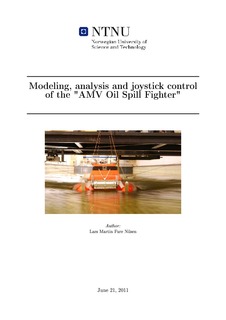| dc.contributor.author | Nilsen, Lars Martin Fure | nb_NO |
| dc.date.accessioned | 2014-12-19T12:06:45Z | |
| dc.date.available | 2014-12-19T12:06:45Z | |
| dc.date.created | 2012-02-13 | nb_NO |
| dc.date.issued | 2011 | nb_NO |
| dc.identifier | 499781 | nb_NO |
| dc.identifier.uri | http://hdl.handle.net/11250/237994 | |
| dc.description.abstract | The purpose of this thesis is to develop a control scheme for the Arctic Multipurpose Vessel Oil Spill Fighter vessel model using a joystick as the connection between vessel and operator. A mathematical model of the vessel is also to be developed using data gathered from experiments done with the vessel model and existing maneuvering model theory. The parameters that are not determined during experiments have all been given an assumed value. The developed mathematical model is, in addition to providing the platform on which to test the controls, meant to be a framework ready for more accurate parameters done by future students.
The Oil Spill Fighter is an amphibious vessel powered by two Archimedes screws that run the length of the vessel on each side of the hull. This is not a unique way of powering an amphibious vessel, but no research have been found on the topic of how such a vessel moves on neither land nor water. This will therefore be discussed in this thesis. The results of this discussion will be appended to the mathematical model of the vessel in order to end up with a model as close to reality as is possible with the determined parameters.
In order to determine what control scheme to pursue, the work space and configuration space of the vessel are discussed. The conclusion of this discussion is to make the land-based control an open-loop control with the joystick providing surge force and yaw moment and the water-based control an autopilot. Those two controllers are then combined to come up with a single model of the amphibious property of the vessel.
When designing the controllers they are kept separate at first in order to simplify the design and tuning. The performance of each is presented and discussed separately and they are then combined into one model. The performance of this combined model is then presented.
The concept of hardware-in-the-loop testing is given an introduction, and the use of this type of testing with regards to the developed models are presented. This involves designing an interface in LabView which is connected to a CompactRIO that holds the model. The concept of real-time calculations are discussed, and a presentation of the developed models performance when uploaded to a CompactRIO and tested in the LabView interface is given. At the end the mathematical model is compared to the results from the experiments. These fit very well, and this result is discussed. | nb_NO |
| dc.language | eng | nb_NO |
| dc.publisher | Norges teknisk-naturvitenskapelige universitet, Fakultet for ingeniørvitenskap og teknologi, Institutt for marin teknikk | nb_NO |
| dc.title | Modeling, analysis and joystick control of the "AMV Oil Spill Fighter" | nb_NO |
| dc.title.alternative | Modellering, analyse, og joystick-basert fjernstyring av fartøyet “AMV Oil Spill Fighter” | nb_NO |
| dc.type | Master thesis | nb_NO |
| dc.contributor.department | Norges teknisk-naturvitenskapelige universitet, Fakultet for ingeniørvitenskap og teknologi, Institutt for marin teknikk | nb_NO |
